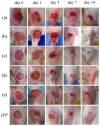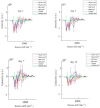Quantitative Assessment of Low-Dose Photodynamic Therapy Effects on Diabetic Wound Healing Using Raman Spectroscopy
- PMID: 36839917
- PMCID: PMC9966264
- DOI: 10.3390/pharmaceutics15020595
Quantitative Assessment of Low-Dose Photodynamic Therapy Effects on Diabetic Wound Healing Using Raman Spectroscopy
Abstract
One of challenges that faces diabetes is the wound healing process. The delayed diabetic wound healing is caused by a complicated molecular mechanism involving numerous physiological variables. Low-dose photodynamic therapy (LDPDT) provides excellent results in rejuvenation and wound healing. In this study, the LDPDT effect on diabetic wounds in mice was studied using two photosensitizers, 5-aminolevulinic acid and methylene blue, and two laser dose expositions of 1 J/cm2 and 4 J/cm2 by Raman spectroscopy (RS). The latter was used as a noninvasive method, providing specific information about tissue state based on the fundamental vibrational modes of its molecular components. RS allows high spatial resolution acquisition of biochemical and structural information through the generation of point spectra or spectral images. An approach to in vivo quantitative assessment of diabetic wound healing state was developed. This approach is based on an application of the principal component analysis combined with the Mahalanobis metrics to skin Raman spectra, in particular, intensities of the amide I and CH2 bands.
Keywords: Mahalanobis distance; Raman spectroscopy; diabetes; low dose photodynamic therapy; principal component analysis; wound healing.
Conflict of interest statement
The authors declare no conflict of interest.
Figures


















References
-
- International Diabetes Federation . IDF Diabetes Atlas. 10th ed. International Diabetes Federation; Brussels, Belgium: 2021. [(accessed on 26 November 2022)]. Available online: https://diabetesatlas.org/
-
- Dinh T., Elder S., Veves A. Delayed Wound Healing in Diabetes: Considering Future Treatments. Diabetes Manag. 2011;1:509–519. doi: 10.2217/dmt.11.44. - DOI
Grants and funding
LinkOut - more resources
Full Text Sources

